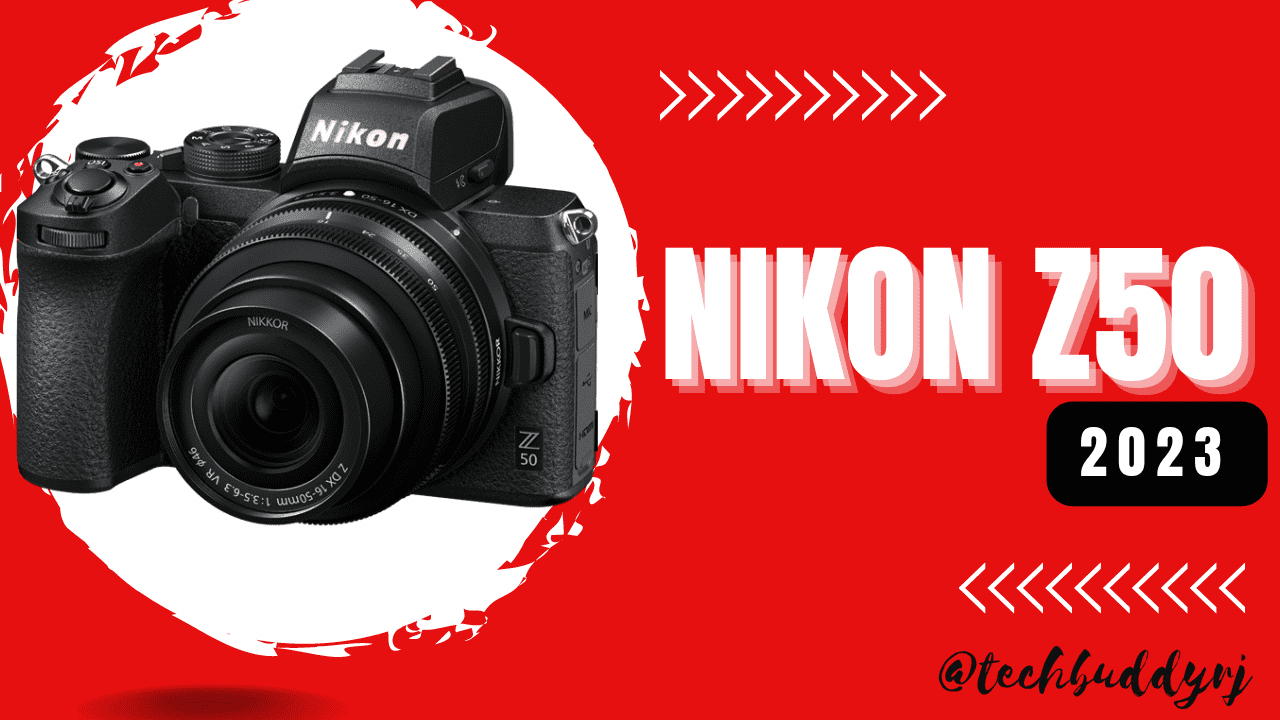Nikon Z50 Introduction
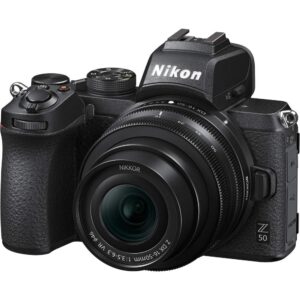
The Nikon Z50 is a mirrorless camera designed for photographers who want a compact, lightweight camera with advanced features and exceptional image quality. It was first released in November 2019 and has since gained popularity among both amateur and professional photographers.
The camera features a 20.9-megapixel DX-format CMOS sensor and an EXPEED 6 image-processing engine, which work together to produce stunning still images and 4K UHD videos. It also has a hybrid autofocus system that combines phase-detection and contrast-detection autofocus for quick and accurate focusing, even in low light conditions.
The Nikon Z50 has a compact and ergonomic design, with a comfortable grip that makes it easy to hold and shoot with one hand. It also has a tilting touchscreen that allows for easy navigation and framing of shots, as well as a high-resolution electronic viewfinder for more traditional shooting.
Other notable features of the Nikon Z50 include built-in Wi-Fi and Bluetooth connectivity, a 11 fps continuous shooting speed, and a wide ISO range of 100-51,200, which allows for shooting in a variety of lighting conditions.
Overall, the Nikon Z50 is a versatile and capable camera that offers advanced features in a compact and lightweight package, making it a great choice for photographers looking for a high-quality mirrorless camera.
Nikon Z50 for Photography
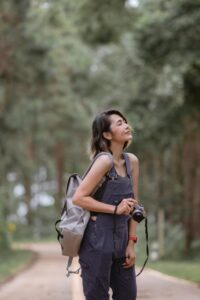
In 2023, the Nikon Z50 is still a great option for photography, particularly for those who want a compact and lightweight camera with advanced features. Here are some key points about the Nikon Z50 that make it a good choice for photography in 2023:
- Image quality: The camera features a 20.9-megapixel DX-format CMOS sensor and an EXPEED 6 image-processing engine, which produce sharp, detailed, and low-noise images even in low-light conditions.
- Autofocus system: The hybrid autofocus system of the Nikon Z50 combines phase-detection and contrast-detection autofocus for quick and accurate focusing, making it a great option for shooting moving subjects.
- Ergonomic design: The camera has a compact and ergonomic design, with a comfortable grip that makes it easy to hold and shoot with one hand. It also has a tilting touchscreen that allows for easy navigation and framing of shots, as well as a high-resolution electronic viewfinder for more traditional shooting.
- Versatility: The Nikon Z50 offers a wide range of shooting modes and settings, including manual, aperture priority, shutter priority, and program modes, allowing photographers to have full control over their images. It also has a wide ISO range of 100-51,200, which allows for shooting in a variety of lighting conditions.
- Connectivity: The camera has built-in Wi-Fi and Bluetooth connectivity, which allows for easy sharing and transferring of images to a smartphone or tablet.
Overall, the Nikon Z50 is still an excellent camera for photography in 2023, particularly for those who are looking for a compact and lightweight option without compromising on image quality or advanced features. It’s a great choice for a variety of photography genres, including landscape, portrait, street, and travel photography.
Nikon Z50 for Videography
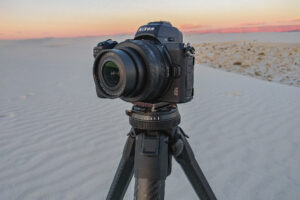
While the Nikon Z50 is primarily known for its still photography capabilities, it also offers some advanced features for videography in 2023. Here are some key points about the Nikon Z50 that make it a good choice for videographers:
- 4K UHD video: The camera is capable of shooting 4K UHD video at up to 30 frames per second, providing excellent video quality.
- Electronic stabilization: The Nikon Z50 has in-camera electronic stabilization which helps to minimize camera shake and produce smoother video footage.
- Tilting touchscreen: The tilting touchscreen makes it easy to monitor and adjust settings while recording video.
- Microphone jack: The camera has a 3.5mm microphone jack, which allows you to connect an external microphone for better audio quality.
- Z-mount lenses: The Nikon Z50 uses the same Z-mount lenses as Nikon’s full-frame mirrorless cameras, which provides access to a wide range of high-quality lenses for different shooting scenarios.
- Time-lapse movie: The camera has a built-in time-lapse movie feature, which allows you to capture stunning time-lapse videos with ease.
Overall, while the Nikon Z50 is not designed specifically for videography, it offers some advanced features that make it a good choice for videographers who want a compact and lightweight camera.
Its 4K UHD video capabilities, in-camera electronic stabilization, tilting touchscreen, and microphone jack make it a good option for a range of videography projects, including travel, vlogging, and amateur filmmaking.
Here are the key features of the Nikon Z50:
- Sensor: 20.9-megapixel DX-format CMOS sensor
- Image processor: EXPEED 6 image-processing engine
- Autofocus: Hybrid autofocus system with 209 AF points (phase-detection and contrast-detection)
- ISO range: 100-51,200 (expandable to 204,800)
- Burst rate: Up to 11 frames per second
- Video: 4K UHD video recording at up to 30 frames per second
- Image stabilization: In-camera electronic stabilization
- LCD screen: 3.2-inch tilting touchscreen with 1,040,000 dots
- Viewfinder: 2.36-million dot OLED electronic viewfinder
- Connectivity: Built-in Wi-Fi and Bluetooth connectivity
- Battery life: Up to 320 shots per charge
- Memory card: Single SD memory card slot (UHS-I compatible)
- Shutter speed: 30 seconds to 1/4000th of a second
- Flash: Built-in pop-up flash
- Microphone jack: 3.5mm microphone jack
- Lens mount: Nikon Z-mount
- Dimensions: 126.5 x 93.5 x 60mm
- Weight: 450g (with battery and memory card)
Overall, the Nikon Z50 is a compact and lightweight camera that packs a lot of advanced features into its small form factor. Its 20.9-megapixel sensor, hybrid autofocus system, and 4K UHD video capabilities make it a great choice for both photography and videography, while its tilting touchscreen and electronic viewfinder provide easy and flexible viewing options.
Additionally, the camera’s built-in Wi-Fi and Bluetooth connectivity make it easy to share and transfer images to other devices, while its Nikon Z-mount provides access to a wide range of high-quality lenses.
Nikon Z50 Body & Design
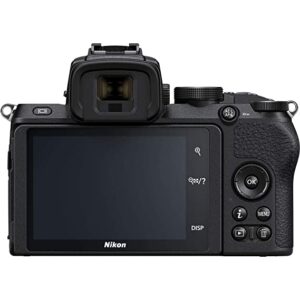
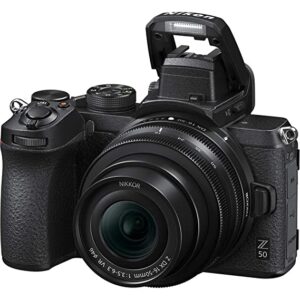
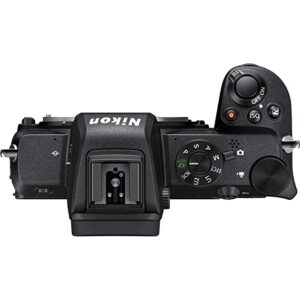
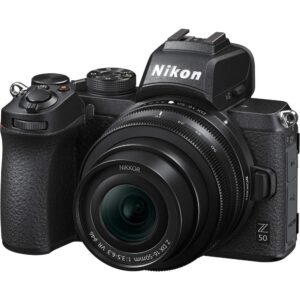
The Nikon Z50 has a sleek and compact design, with a body made of durable magnesium alloy. Here are some key features of the Nikon Z50 body and design:
- Ergonomic grip: The camera has a deep and comfortable grip that makes it easy to hold and shoot with one hand.
- Buttons and controls: The buttons and controls on the camera are well-placed and easy to access, with a mode dial on top of the camera and function buttons on the back.
- Tilting touchscreen: The camera has a 3.2-inch tilting touchscreen that allows for easy navigation and framing of shots.
- Electronic viewfinder: The high-resolution 2.36-million dot OLED electronic viewfinder provides a clear and detailed view of the scene.
- Pop-up flash: The camera has a built-in pop-up flash for additional lighting options.
- Lens mount: The camera uses the Nikon Z-mount, which allows for a wide range of compatible lenses.
- Weather-sealing: The camera is not fully weather-sealed, but it does have some degree of dust and moisture resistance.
- Dimensions: The camera measures 126.5 x 93.5 x 60mm, making it a compact and portable option.
- Weight: The camera weighs 450g (with battery and memory card), which is relatively lightweight compared to some other mirrorless cameras.
Nikon Z50 ( Viewfinder )
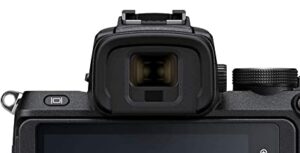
The Nikon Z50 features a high-resolution OLED electronic viewfinder (EVF) that provides a clear and detailed view of the scene. Here are some key features of the Nikon Z50 viewfinder:
- Resolution: The viewfinder has a resolution of 2.36 million dots, which provides a clear and detailed view of the scene.
- Magnification: The viewfinder has a magnification of 0.68x, which provides a large and immersive view of the scene.
- Eye sensor: The camera has an eye sensor that automatically switches between the EVF and the rear LCD screen when the camera is raised to the eye.
- Diopter adjustment: The viewfinder has a diopter adjustment that allows users to adjust the focus of the viewfinder to their individual eyesight.
- Information display: The viewfinder displays a range of shooting information, including exposure settings, battery life, and autofocus status.
- Brightness and color adjustment: The viewfinder brightness and color temperature can be adjusted to suit the user’s preferences.
Nikon Z50 ( LCD Screen )
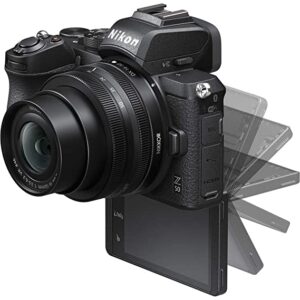
The Nikon Z50 features a 3.2-inch tilting touchscreen LCD panel on the back of the camera. Here are some key features of the Nikon Z50 LCD panel:
- Size and resolution: The LCD panel is 3.2 inches in size and has a resolution of 1,040,000 dots.
- Touchscreen: The LCD panel is a touchscreen that allows users to navigate the camera’s menu system, change settings, and select focus points.
- Tilting design: The LCD panel is mounted on a hinge that allows it to be tilted up or down, making it easier to compose shots from high or low angles.
- Information display: The LCD panel displays a range of shooting information, including exposure settings, battery life, and autofocus status.
- Live view: The LCD panel can be used for live view, allowing users to compose shots and preview the effect of exposure settings and other shooting parameters.
- Playback: The LCD panel can be used for playback of images and videos, allowing users to review their shots and delete or edit them if necessary.
- Virtual horizon: The LCD panel includes a virtual horizon feature that displays a horizontal line to help users level the camera.
Nikon Z50 ( USB Ports )
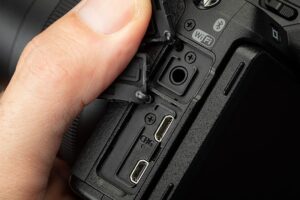
The Nikon Z50 has a range of ports that allow for connectivity and data transfer. Here are some key ports on the Nikon Z50:
- USB Type-C port: The camera has a USB Type-C port that can be used for charging the battery, transferring images and videos, and connecting to a computer.
- Microphone jack: The camera has a 3.5mm microphone jack that allows users to connect an external microphone for improved audio quality.
- HDMI port: The camera has a micro HDMI port that allows users to connect the camera to an external monitor or display.
- Remote control port: The camera has a dedicated port for connecting a remote control device, such as the Nikon ML-L7 wireless remote control.
- Accessory port: The camera has a dedicated accessory port that allows users to connect accessories such as the Nikon DF-M1 dot sight.
Overall, the Nikon Z50 has a range of ports that allow for connectivity and flexibility when shooting, making it a versatile camera for a range of photography and videography applications.
Nikon Z50 ( Battery )
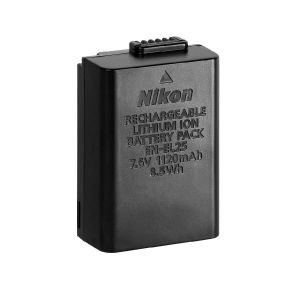 The Nikon Z50 uses a single EN-EL25 rechargeable lithium-ion battery for power. Here are some key features of the battery and card slot of the Nikon Z50:
The Nikon Z50 uses a single EN-EL25 rechargeable lithium-ion battery for power. Here are some key features of the battery and card slot of the Nikon Z50:
- Battery life: The EN-EL25 battery is rated for approximately 320 shots per charge when using the viewfinder or 840 shots per charge when using the LCD screen.
- Charging: The battery can be charged using the included MH-32 battery charger, or via USB charging while the battery is in the camera.
- Battery grip: The camera can be fitted with the optional MB-N10 battery grip, which can hold two EN-EL25 batteries for extended shooting time.
- Memory card slot: The Nikon Z50 features a single memory card slot that supports SD, SDHC, and SDXC memory cards. The memory card slot is located on the side of the camera.
- Dual memory card slot: Unfortunately, the Nikon Z50 does not have a dual memory card slot, which means you cannot have a backup of your files when shooting.
Nikon Z50 ( Sensor )
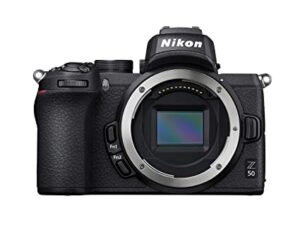
The Nikon Z50 features a 20.9 megapixel APS-C CMOS sensor that is designed specifically for the camera’s Z mount. Here are some key details about the Nikon Z50 sensor:
- Sensor size: The sensor size is APS-C, which is smaller than a full-frame sensor but larger than the sensors found in many entry-level DSLRs.
- Sensor resolution: The sensor has a resolution of 20.9 megapixels, which is capable of producing detailed images with good dynamic range and low noise.
- Image processor: The Nikon Z50 features the EXPEED 6 image processor, which helps to reduce noise and improve image quality at high ISO settings.
- ISO range: The camera has an ISO range of 100-51,200, which can be extended to ISO 204,800 in the “Hi” setting.
- Autofocus system: The Nikon Z50 has a hybrid autofocus system with 209 phase-detection autofocus points that cover approximately 90% of the frame.
- Electronic shutter: The camera features an electronic shutter that can shoot at speeds of up to 1/4000 sec, or up to 1/32000 sec in the Hi setting.
Overall, the Nikon Z50 sensor is a high-quality APS-C CMOS sensor that is capable of producing excellent image quality, particularly when paired with the camera’s advanced autofocus system and image processor.
READ MORE – Nikon Z6II vs Sony A7III Comparison Review
Nikon Z50 ( Video )

The Nikon Z50 has a range of video features that make it a capable camera for shooting high-quality videos. Here are some key video features of the Nikon Z50:
- Video resolution: The Nikon Z50 can shoot 4K UHD video at 30 frames per second (fps) and 1080p full HD video at up to 120 fps for slow-motion playback.
- Video codecs: The camera supports the H.264/MPEG-4 AVC and H.265/HEVC video codecs for recording video.
- Time-lapse movie: The camera has a built-in time-lapse movie function that allows users to create time-lapse videos easily.
- Slow-motion video: The camera can record slow-motion videos at up to 120 fps in Full HD resolution.
- Autofocus system: The Nikon Z50’s autofocus system, with 209 phase-detection autofocus points, works well for video recording, and can track subjects smoothly and accurately.
- Electronic stabilization: The camera features electronic stabilization to reduce camera shake when recording handheld footage.
- External microphone input: The camera has a 3.5mm microphone input for connecting an external microphone to improve audio quality.
Overall, the Nikon Z50 has a range of video features that make it a versatile camera for videography, particularly for those who need a compact and portable camera for on-the-go shooting. While it may not have all the advanced video features of some higher-end cameras, it still offers a solid set of tools for creating high-quality videos.
Nikon Z50 ( Wedding Photography or Videography)
The Nikon Z50 can be used for wedding photography and videography, but it may not be the best choice for all wedding photographers and videographers. Here are some factors to consider:
For wedding photography:
- The Z50’s autofocus system is fast and accurate, making it a good option for capturing candid moments and fast-moving subjects.
- The camera’s small size and lightweight make it easy to carry around and use for extended periods of time.
- The Z50 can use F-mount lenses with an adapter, which means that photographers who already own Nikon lenses can use them with this camera.
- However, the limited battery life and lack of dual card slots may be a drawback for wedding photographers who need to shoot for extended periods of time and backup their images on the go.
For wedding videography:
- The Z50 can shoot 4K video at 30 frames per second and 1080p video at 120 frames per second for slow-motion footage, making it a good option for capturing high-quality video.
- The camera’s compact size and lightweight make it easy to use for handheld shooting or for mounting on a gimbal or stabilizer.
- However, the lack of in-body image stabilization and dedicated headphone jack may be a drawback for videographers who need smooth footage and the ability to monitor audio while recording.
Overall, the Nikon Z50 can be a good choice for wedding photography and videography, particularly for those who value its small size, good autofocus, and compatibility with Nikon lenses.
However, photographers and videographers should carefully consider their specific needs and the camera’s limitations before choosing it for a wedding shoot.
Nikon Z50 ( Night Photography or Videography )
The Nikon Z50 can be a good camera for night photography or videography, but its performance in low light conditions may not be as good as some full-frame cameras with larger sensors. Here are some key considerations for night photography or videography with the Nikon Z50:
- ISO performance: The Nikon Z50 has a maximum ISO sensitivity of 51,200, which can be extended up to ISO 204,800 in the Hi setting. While this high ISO performance can be useful for low-light situations, it may also introduce noise or grain in the image.
- Autofocus performance: The Nikon Z50’s autofocus system, with 209 phase-detection autofocus points, works well in low-light conditions, but it may struggle in extremely dark environments.
- Lens options: The Nikon Z50 has a growing lineup of Z-mount lenses, including fast prime lenses that can be useful for night photography or videography.
- Image stabilization: The Nikon Z50 features electronic image stabilization, which can help to reduce camera shake in low-light situations when shooting handheld.
- Long exposures: The camera can shoot long exposures up to 900 seconds, which can be useful for capturing nightscapes and star trails.
- Noise reduction: The Nikon Z50 has several noise reduction options that can help to reduce noise in images shot at high ISO settings.
Overall, the Nikon Z50 can be a good camera for night photography or videography, particularly for those who need a compact and portable camera for on-the-go shooting.
However, its performance in low light conditions may not be as good as some full-frame cameras with larger sensors.
Nikon Z50 ( Travel or Street Photography )
The Nikon Z50 is a versatile camera that can be a good choice for travel or street photography, particularly for those who need a compact and portable camera for on-the-go shooting. Here are some key considerations for using the Nikon Z50 for travel or street photography:
- Size and weight: The Nikon Z50 is a relatively small and lightweight camera, which makes it easy to carry around for extended periods of time.
- Lens options: The Nikon Z50 has a growing lineup of Z-mount lenses, including several compact and lightweight options that are well-suited for travel or street photography.
- Autofocus system: The Nikon Z50’s hybrid autofocus system, with 209 phase-detection autofocus points, works well for tracking moving subjects and can help to ensure that shots are in focus.
- Electronic viewfinder: The camera’s electronic viewfinder provides a clear and detailed view of the scene, which can be helpful for composing shots in bright sunlight.
- Tilting LCD screen: The Nikon Z50’s tilting LCD screen can be useful for shooting from low angles or for composing shots in crowded or busy environments.
- Battery life: The Nikon Z50 has a relatively long battery life, which can be helpful for extended periods of shooting.
Overall, the Nikon Z50 is a capable camera for travel or street photography, particularly for those who need a compact and portable camera for on-the-go shooting. Its small size and lightweight design, combined with its advanced autofocus system and lens options, make it a versatile tool for capturing memorable travel and street photography images.
Nikon Z50 for Vlogging
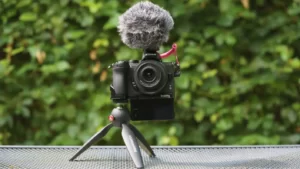
In 2023, the Nikon Z50 can still be a good choice for vlogging, particularly for those who prioritize image quality and compatibility with Nikon lenses. However, there are some newer and more advanced options on the market that may be worth considering as well. Here are some factors to consider when choosing a camera for vlogging in 2023:
- Image quality: Vloggers typically want a camera that can produce high-quality video and images. In 2023, there are many cameras on the market that can shoot 4K video and offer advanced features like high frame rates and HDR.
- Autofocus: Fast and accurate autofocus is important for vlogging, as it allows you to stay in focus while moving around. Many newer cameras offer advanced autofocus systems that can track subjects and maintain focus even in challenging situations.
- Size and weight: Vloggers often need to carry their camera around with them, so a small and lightweight camera can be an advantage. However, larger cameras may offer more advanced features and better image quality.
- Audio: Good audio is crucial for vlogging, so a camera with a built-in microphone or the ability to connect an external microphone is important.
- Connectivity: In 2023, many cameras offer advanced connectivity options like Wi-Fi and Bluetooth, which can make it easier to transfer files and control the camera remotely.
Overall, the Nikon Z50 can still be a good choice for vlogging in 2023, particularly for those who already own Nikon lenses. However, it’s worth considering other options on the market to find a camera that meets your specific needs and preferences.
Nikon Z30 Pro & Cons
Conclusion
In conclusion, the Nikon Z50 is a solid mirrorless camera that offers a good balance of size, image quality, autofocus, and video capabilities. Its compact size and lightweight make it a great option for travel and everyday use, while its image quality and autofocus make it a reliable choice for capturing high-quality photos and videos.
However, it does have some drawbacks, including a limited lens selection, no in-body image stabilization, limited battery life, and a lack of dual card slots and a headphone jack. Despite these limitations, the Nikon Z50 is a great choice for photographers and videographers who want a capable mirrorless camera in a small package, especially those who already own Nikon lenses.

